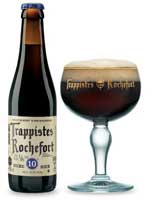BELGIAN AND FRENCH ORIGIN
Belgian-Style Flanders Oud Bruin or Oud Red Ales
Belgian-style Flanders oud bruin ale is copper to very dark ale in color.
Chill haze is acceptable at low serving temperatures. They have a
cocoa-like character from roast malt. Roasted malt character in aroma and
flavor is acceptable at low levels. A very low degree of malt sweetness may
be present and in balance with the acidity produced by Lactobacillus
activity. Flanders brown ales are perceived to have a low to medium hop
bitterness though acidity and wood aging (if used) may mask higher
bitterness unit level. Its overall balance is characterized by a slight to
strong lactic sourness, and with “Reds” sometimes a balanced degree of
acetic acid. Brettanomyces produced flavors and aromas may be completely
absent or at very low levels. A fruity-estery character which is often
cherry-like is apparent with no hop flavor or aroma. Oak-like or woody
characters may be pleasantly integrated into overall palate. Mouthfeel
should be refreshing. Some versions may be more highly carbonated and, when
bottle conditioned, may appear cloudy (yeast) when served. These final
beers are often blended old with new before packaging in order to create
the brewer’s intended balance of characters. Beers with infused fruit
character should be entered into other fruit beer categories.
Original Gravity (ºPlato) 1.044-1.056 (11-14 ºPlato) ● Apparent
Extract/Final Gravity (ºPlato) 1.008-1.016 (2-4 ºPlato) ● Alcohol by
Weight (Volume) 3.8-5.2% (4.8-6.5%) ● Bitterness (IBU) 15-35 ●
Color SRM (EBC) 12-25 (24-50 EBC)
Belgian-Style Dubbel
Belgian-style dubbel ranges from brown to very dark in color. Chill haze is
acceptable at low serving temperatures. They have a malty sweetness and
chocolate-like caramel aroma. Hop bitterness is medium-low to medium. A low
hop flavor and/or aroma is acceptable. Diacetyl should not be perceived.
Yeast-generated fruity esters (especially banana) are appropriate at low
levels. Head retention is dense and mousse-like. Often bottle conditioned a
slight yeast haze and flavor may be evident.
Original Gravity (ºPlato) 1.060-1.075 (14.7-18.2 ºPlato) ● Apparent
Extract/Final Gravity (ºPlato) 1.012-1.016 (3-4 ºPlato) ● Alcohol by
Weight (Volume) 5-6.0% (6.25-7.5%) ● Bitterness (IBU) 20-30 ●
Color SRM (EBC) 16-36 (32-72 EBC)
Belgian-Style Tripel
Belgian-style tripel ranges from pale to medium-amber in color. Head
retention is dense and mousse-like. Chill haze is acceptable at low serving
temperatures. Traditional tripels are bottle conditioned, may exhibit
slight yeast haze but the yeast should not be intentionally roused. Brewing
sugar may be used to lighten the perception of body. Low sweetness will
come from very pale malts. There should not be character from any roasted
or dark malts. Hop/malt balance is equalizing. The overall beer flavor may
finish sweet, though any sweet finish should be light. Hop bitterness is
perceived as medium to medium-high. Low hop flavor and aroma is acceptable.
Tripels are often characterized by a complex, sometimes mild spicy
character. Clove-like phenolic flavor and aroma may be evident at very low
levels. Yeast-generated fruity esters including banana are also common but
not necessary. Traditional Belgian-style tripels are often well attenuated.
Alcohol strength and flavor should be perceived as evident. The beer is
characteristically medium body. Oxidative character if evident in aged
tripels should be mild and pleasant.
Original Gravity (ºPlato) 1.070-1.092 (17-22 ºPlato) ● Apparent
Extract/Final Gravity (ºPlato) 1.008-1.018 (2-4.5 ºPlato) ● Alcohol
by Weight (Volume) 5.6-8.0% (7.0-10.0%) ● Bitterness (IBU) 20-45
● Color SRM (EBC) 4-9 (8-18 EBC)
Belgian-Style Quadrupel Belgian-style quadrupel is amber to dark
brown in color. Chill haze is acceptable at low serving temperatures. A
mousse-like dense, sometimes amber head will top off a properly poured and
served quad. Caramel, dark sugar and malty sweet flavors and 12
aromas can be intense, not cloying, while complementing fruitiness. Hop
characters do not dominate; low to low-medium bitterness is perceived. None
to very low hop flavor and aroma may be present. Quadrupels or “quads” are
characterized by the immense presence of alcohol and balanced flavor,
bitterness and aromas. Complex fruity aroma and flavor emerge reminiscent
of raisins, dates, figs, grapes, plums often accompanied with a hint of
winy character. Though well attenuated it usually has a full, creamy body.
Perception of alcohol can be extreme. Clove-like phenolic flavor and aroma
should not be evident. Diacetyl and DMS should not be perceived. Well
balanced with savoring/sipping drinkability. Oxidative character if evident
in aged Quads should be mild and pleasant.
Original Gravity (ºPlato) 1.084-1.120 (20.2-28 ºPlato) ● Apparent
Extract/Final Gravity (ºPlato) 1.014-1.020 (3.5-5 ºPlato) ● Alcohol
by Weight (Volume) 7.2-11.2% (9-14%) ● Bitterness (IBU) 25-50 ●
Color SRM (EBC) 8-20 (16-40 EBC)
Belgian-Style Dark Strong Ale
Belgian-style dark strong ales are medium-amber to very dark in color.
Chill haze is allowable at cold temperatures. The intensity of malt
character can be rich, creamy, and sweet with intensities ranging from
medium to high. Fruity complexity along with the soft flavors of roasted
malts add distinct character. Often, though not always, brewed with dark
Belgian "candy" sugar, these beers can be well attenuated, ranging from
medium to full-bodied. The perception of hop bitterness is low to medium,
with hop flavor and aroma also in this range. The alcohol strength of these
beers can often be deceiving to the senses. Very little or no diacetyl is
perceived. Herbs and spices are sometimes used to delicately flavor these
strong ales. Low levels of phenolic spiciness from yeast byproducts may
also be perceived.
Original Gravity (ºPlato) 1.064-1.096 (16-23 ºPlato) ● Apparent
Extract/Final Gravity (ºPlato) 1.012-1.024 (3-6 ºPlato) ● Alcohol by
Weight (Volume) 5.6-8.8% (7.0-11.0%) ● Bitterness (IBU) 20-50 ●
Color SRM (EBC) 9-35 (18-70 EBC)
Disclaimer: Unchanged: "2013 Brewers Association Beer Style Guidelines used
with permission of Brewers Association"
Source: http://www.brewersassociation.org/pages/business-tools/publ
ications/beer-style-guidelines
















